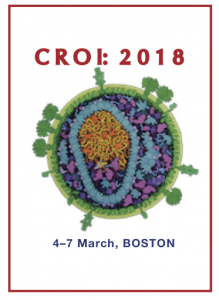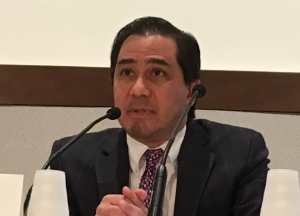Inching towards an HIV cure: bNAb and TLR-7 agonist reduce viral rebound off-ART in macaques
14 March 2018. Related: Conference reports, Cure-related research, CROI 25 (Retrovirus) 2018.
 Simon Collins, HIV i-Base
Simon Collins, HIV i-Base
Press-released before the results were presented in full, CROI 2018 highlighted the importance of cure research with results from a proof-of-principle study in macaques showing that treatment with broadly neutralising antibodies (bNAbs) might play a role in key stages for an HIV cure.
These are early results, and these are animal data, but they are encouraging for showing a delay in viral rebound in half the animals after stopping SHIV treatment, with significantly slower rates of viral rebound and to lower levels.

Dan Barouch at CROI 2018 press conference
Top-line results were presented by Dan Barouch study from Beth Israel Deaconess Medical Center, Boston, using the bNAb PGT121 combined with the TLR-agonist GS-9620 (Vesatolimod), an investigational compound in development by Gilead). Full results were presented on Tuesday morning. [1]
The study involved infecting 44 rhesus macaque monkeys with SHIV, and treating them with daily ART (dolutegravir/TDF/FTC) from day seven (during acute infection) for two years. The animals were then randomised to one of four groups (each n=11):
- 10 mg/kg PGT121 by infusion (every 2 weeks x 5 doses).
- 0.15 mg/kg GS-9620 by oral gavage (every 2 weeks x 10 doses).
- Both PGT121 and GS-9620.
- Placebo (sham) controls.
ART was then discontinued 16 weeks after the last intervention and viral load monitored.
PGT121 antibody levels were detected throughout treatment and SHIV DNA was significantly lower in the dual vs placebo animals (p=0.004), but became undetectable (in blood, lymph nodes and colorectal tissue) eight weeks before ART was stopped.
Viral load rebounded in all animals in the placebo arm at median 21 days (IQR 21 to 42), compared to only 6/11 animals in the dual therapy intervention rebounding by 140 days (p=0.03), with significantly longer time to rebound, median 112 days (IQR 84 to 140+), (p=0.0005). Peak viral load and viral setpoint were also significantly lower by –2.54 log and –1.52 log, respectively (both p<0.0005). Intermediate responses were seen with each or the single therapy interventions. See Table 1.
Additional details on this study are included in press releases from NIAID who sponsored this study and Gilead who are developing GS-9620. [2, 3]
Table 1: Responses after stopping ART in placebo vs dual arms
| Placebo | PGT121 + GS-9620 | p | |
| No. with rebound | 11/11 | 6/11 | 0.03 |
| Med, time to rebound (days) | 21 days
(IQR 21 to 42) |
112 days
(IQR 84 to 140+) |
0.0005 |
| Setpoint VL | 12,500 | < 400 c/mL | –1.52 log difference p<0.0001) |
comment
These results show that bNAbs can significantly impact viral dynamics when ART is started in acute infection and later discontinued. The researchers stressed however that these are very preliminary results in relation to an HIV cure.
The mechanism for the impact observed on viral dynamics is not well understood. Importantly, these compounds stimulate general CD4 responses, rather than specifically targeting HIV-infected cells in the reservoir.
Also, it is uncertain how results obtained against the lab-created SIV-HIV chimeric virus SHIV-SF162P3 (which has mostly been used for prevention experiments) will translate to HIV in humans.
Several research groups are leading interventions using bNAbs with potential for prevention (PrEP and vaccine strategies) and treatment. While current bNAbs have interesting though limited application, development of more potent and broad compounds are expected and use in combinations provides exciting potential for future research.
References
- Borducchi E et al. PGT121 combined with GS-9620 delays viral rebound in SHIV-infected rhesus monkeys. CROI, 3-6 March 2018. Oral late-breaker abstract 73LB.
http://www.croiconference.org/sessions/pgt121-combined-gs-9620-delays-viral-rebound-shiv-infected-rhesus-monkeys (abstract)
http://www.croiwebcasts.org/console/player/37169 (webcast) - NIAID press release. Broadly neutralizing antibody treatment may target viral reservoir in monkeys: NIH-supported scientists find combination therapy suppresses HIV-like virus in primates. (04 March 2018)
https://www.niaid.nih.gov/news-events/broadly-neutralizing-antibody-treatment-may-target-viral-reservoir-monkeys - Gilead press release. Gilead announces data from new preclinical study evaluating a combination of an investigational TLR7 agonist and an investigational HIV envelope targeting antibody in SHIV-infected, virally suppressed monkeys. (04 March 2018).
http://www.gilead.com/news/press-releases

